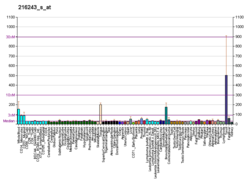Function
IL-1RA is a member of the interleukin 1 cytokine family. IL-1RA is secreted by various types of cells including immune cells, epithelial cells, and adipocytes, and is a natural inhibitor of the pro-inflammatory effect of IL1β. [8] This protein inhibits the activities of interleukin 1, alpha (IL1A) and interleukin 1, beta (IL1B), and modulates a variety of interleukin 1 related immune and inflammatory responses. This gene and five other closely related cytokine genes form a gene cluster spanning approximately 400 kb on chromosome 2. Four alternatively spliced transcript variants encoding distinct isoforms have been reported. [9]
Clinical significance
A polymorphism of this gene is reported to be associated with increased risk of osteoporotic fractures [10] and gastric cancer. [11]
Biallelic deleterious mutations in the IL1RN gene results in a rare autoinflammatory disease called deficiency of the interleukin-1–receptor antagonist (DIRA). [12] Variants of the IL1RN gene is also associated with risk of schizophrenia. [13] [14] Elevated levels of IL-1RA has been found in serum of schizophrenia patients. [15]
In treatment of temporomandibular joint osteoarthritis (TMJOA) the messenger RNA (mRNA) of IL-1RA can be used. The IL-1RA mRNA reduces pain and joint inflammation by blocking inflammatory cascade signals that lead to osteoarthritis progression. [16]
A recombinant, slightly modified version of interleukin 1 receptor antagonist called anakinra is used in the treatment of rheumatoid arthritis, an autoimmune disease in which IL-1 plays a key role. [17] Anakinra differs from native human IL-1RA in that it has the addition of a single methionine residue at its amino terminus [18]
The cytoplasmic and secreted isoforms of IL-1RA can suppress tumors such as squamous cell carcinoma. The cytoplasmic isoform can protect epithelial cells from environmental factors and compete with IL1A in binding with receptors preventing activation. Then, the secreted isoform regulates IL1B in tumor microenvironments by inhibiting glycolysis of IL1B and proliferation of tumor cells, thus preventing the movement of tumor cells. [19]
Use in horses
Interleukin 1 receptor antagonist is used in horses for the treatment of equine lameness secondary to joint and soft-tissue injury. IL-1RA obstructs the IL1B inflammatory cascade rather than helping to restore damaged tissue. [20]
This page is based on this
Wikipedia article Text is available under the
CC BY-SA 4.0 license; additional terms may apply.
Images, videos and audio are available under their respective licenses.









